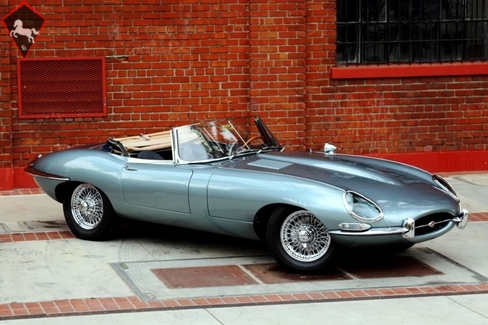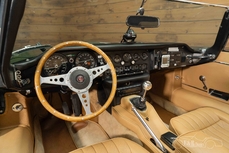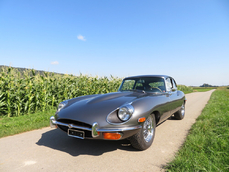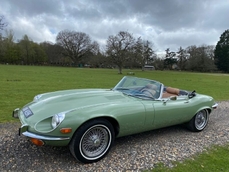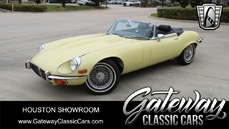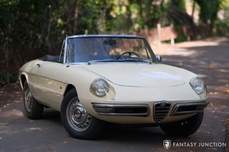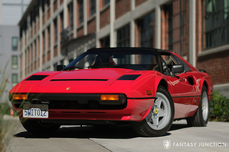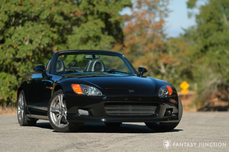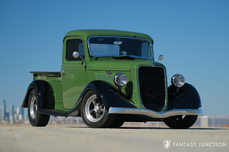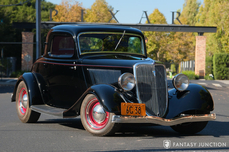Jaguar E-type 3.8 Litre 6-Cylinder DOHC no. R2302-9 1962
Allgemeine Beschreibung :
1962 Jaguar E-Type Series I Roadster
s/n 875865, Engine no. R2302-9
Opalescent Blue with Dark Blue Leather Interior
Once in a lifetime, beauty, engineering, and performance converge, resulting in an object so delightful it transcends generations of admirers. The Jaguar E-Type is exactly such a car. Unveiled at the 1961 Geneva Motor Show, those in attendance were witnessing something miraculous. Stunning design, unrivaled performance, and racing lineage made the E-Type an immediate sensation. With its beautiful, uncluttered design and surprisingly affordable price, the E-Type grew to iconic status where it has remained for more than half a century. But it wasn’t beauty alone that launched this iconic car. Jaguar’s racing experience delivered a car with independent front and rear suspension, disc brakes all around (inboard at the rear to reduce unsprung weight), and power supplied by the legendary twin-cam inline-6 cylinder engine. Sales were brisk, affording ongoing development and advancements that would cover another decade of production. Over time, however, the original flat floor, welded louver cars became something of a legend, in part due to their being the very first E Type.
This particular car was built on October 23rd, 1961 and registered as a 1962 model. Factory reference materials indicate that the outside bonnet latches were phased out of production about a week prior to this car being constructed. The factory flat floor and welded louvers remain on the car as they were when originally completed. The car was sold new to G.E. Sloan of Joliet, Illinois where it was used for some years, eventually finding its way to Mississippi. In the early 1990s, the next owner, famed collector Peter Mullin of Los Angeles, CA, purchased the car with the intent of fully restoring it. However, Mullin decided to concentrate his resources on his Art Deco collection, leaving the car to a new owner. In 1998, the current owner of Pasadena, CA took over the project. The car was completely disassembled, but the engine and wishbone rear end assembly had already been professionally rebuilt, crated and prepared for installation. Though the car was complete and faithfully tended to, the rotisserie restoration of the body, trim, and careful collection of correct parts would take another decade to complete in order to restore an absolutely factory correct early E-Type roadster of impeccable distinction.
The engine finish was carefully researched, determining that the correct head color was indeed Pumpkin Orange and not the typically seen metallic Gold. Additionally the headlight buckets are properly painted body color, though later series cars were painted silver. And while every detail of the restoration was carefully studied for accurate application, the added plus is that this car retains the original engine block and head, original chassis, and a correct Moss gearbox (though not the factory original unit). A team of specialists with expertise in Jaguar cars was assigned to complete the restoration. Reed Jensen of Glendale, CA performed all mechanical work, Classic Vision of Burbank, CA applied the stunning Light Opalescent Blue paint over their superb bodywork, and Tony D’Allesandro of Los Angeles, CA thoughtfully tailored the factory correct interior. The correct convertible top was replaced in 2016 and new Vredestein tires were also recently installed.
Today, the award winning condition of this car is simply stunning. The color combination is breathtaking both in finish and presentation. Awards stretch back for nearly a decade with continual updating and detailing to improve the car. The most recent of several JOC events (2015) resulted in 99.40 points. Other significant shows and wins include:
2017 San Marino Motor Classic – 2nd in Class
2016 La Jolla Concours d”Elegance – Best in Class
2014 San Marino Motor Classic – 2nd in Class
2014 San Marino Motor Classic – Mayor’s Award
2014 Palos Verdes Concours d’Elegance – 2nd in Class
2012 Dana Point Concours d’Elegance – Best in Class
2012 Palos Verdes Concours d’Elegance – Best in Class
2012 San Marino Motor Classic – Best in Class
2011 Dana Point Concours d’Elegance - 2nd in Class
2011 Palos Verdes Concours d’Elegance – 2nd in Class
2010 Los Angeles Conrours d’Elegance – Best in Class
2008 Los Angeles Conrours d’Elegance – Best in Class
The paint is essentially as new with beautiful gloss and deep metallic luster, having been comprehensively repainted in 2017 due to the current owners penchant for absolute excellence. All of the chrome trim is beautifully plated with excellent finish and luster. Only slight mellowing appears on the chrome. The body integrity is outstanding, with beautiful and consistent shut lines and tight closures on doors, trunk, and bonnet. All trim, script, and piping have been applied with jewel-like care and precision. The brilliant wire wheels are shod with new Vredestein tires, properly fitting the E-Types beautifully scalloped wheel openings. Stance on the car is perfectly composed, hinting appropriately at the lunging animal shapes so beautifully sculpted more than half a century ago.
The interior is in exceptional condition having been both thoughtfully and expertly redone with correct leather and trim, tight piping, proper padding, excellent quality carpeting, and a pristine dashboard. Instruments and switches are meticulously detailed showing excellent color and clarity on the faces and glass. Fit and finish throughout the interior once again is among the finest anyone will find in any XKE as the JOC judging sheets indicate. Discreet yet effective modifications have been made to the interior to more comfortably accommodate a driver of 6’2” in height.
The engine compartment is beautifully composed in appearance and detail with all components, hardware, hoses, and lines correctly prepared as originally intended. A few of the heat sensitive finishes have been upgraded to improve longevity while still maintaining a proper visual impression. The original block is in place with the original head also retained and properly restored to correct early Series I specifications. As one might expect, the undercarriage is in excellent condition, with all structural panels sound throughout and impeccable attention to detail including excellent bodywork as the panels roll under the bottom of the car. There is no evidence of structural damage. All finishes and components viewed in the undercarriage appear as tidy as the rest of the car. The overall integrity of the body seams and joinery is very nice and further speaks to the high quality of restoration and diligent ongoing care this car has received throughout the years since the restoration was completed.
In addition to the astonishing cosmetics, this E-Type roadster runs and drives extremely well, starting easily and settling in quickly to steady and smooth idle. Recent adjustments have been performed as needed in order to preserve the performance capabilities in keeping with the high visual standards. The engine has great oil pressure, makes excellent power and torque, and pulls strong in all gears. The car accelerates to freeway speeds rapidly with no shudder or stall in acceleration. The car tracks exceptionally well and rides smoothly, further validating the superb original engineering. Steering is excellent, while cornering and braking are very much in keeping with the times. Accompanying the car are records and receipts from the extensive restoration, some reference literature, and tools, jack, grease gun, driver’s side seat rails, a box of helpful extras to include taillight lenses and intake manifolds, as well as a very sporting “Austin Powers” car cover.
Jaguar E-Type roadsters are highly prized for their beauty and performance prowess. Early Series I cars are further considered among the most sought after models, having been the very first conceived by Jaguar Motors. Combining great colors, a superb and highly decorated restoration, and meticulous ownership, this stunning car – restored by premier enthusiasts, for enthusiasts – simply captures all the magic of the original Jaguar E-Type, beckoning you to drive, show, and enjoy for years to come.
http://fantasyjunction.com/cars/2021-Jaguar-XKE%20Roadster-3.8%20Litre%206-Cylinder%20DOHC
1962 Jaguar E-type 3.8 Litre 6-Cylinder DOHC no. R2302-9 is listed verkauft on ClassicDigest in Emeryville by Fantasy Junction for $225000.
Fakten der Auto
Karosserietyp : Auto Marke : Jaguar Modell : E-type Ausführung : 3.8 Litre 6-Cylinder DOHC no. R2302-9 Hubraum : 3.8 Modelljahr : 1962 Lage : Emeryville
Verkauft
Angaben Zum Verkäufer
Verkauft
People who viewed this Jaguar E-type also viewed similar Jaguar listed at ClassicDigest
Other cars listed for sale by this dealer
über Jaguar
Ah, die Geschichte von Jaguar, von seinen Anfängen als SS Cars Ltd. bis hin zum Höhepunkt mit dem D-Typ und der Straßenversion des ikonischen E-Typs. An dieser Erzählung haftet etwas zutiefst Britisches, und ich werde sie erzählen, wie es ein britischer Journalist tun würde.Die Anfänge:
Unsere Reise in die Welt von Jaguar beginnt in den 1930er Jahren, als ein Unternehmen namens SS Cars Ltd. auftauchte. Trotz des unglücklichen Zufalls ihrer Initialen, die mit den aufkommenden politischen Spannungen in Europa zusammenfielen, begannen sie, stilvolle und leistungsorientierte Autos herzustellen. Der SS 100, der 1936 eingeführt wurde, war ein Symbol für Eleganz und Geschwindigkeit und legte den Grundstein für das, was Jaguar werden sollte.
Die Geburt von Jaguar:
Als der Schatten des Zweiten Weltkriegs näher rückte, entschied sich SS Cars Ltd. klugerweise, sich von den SS-Initialen zu distanzieren. So wurden sie 1945 offiziell zu Jaguar Cars Ltd., ein Name, der bald für britischen Luxus und Leistung stehen würde.
Die XK-Serie:
Die Nachkriegszeit von Jaguar brachte uns den XK 120, eine wahre Sensation im Jahr 1948. Mit seinem schlanken Design und einem leistungsstarken 3,4-Liter-Sechszylindermotor wurde er zum schnellsten Serienauto der Welt. Der XK 120 war die Blaupause für das, was kommen würde - Jaguars, die Stil mit Geschwindigkeit auf einzigartig britische Weise verbanden.
Die Dominanz des D-Typs:
Dann kam der D-Typ, eine wahre Rennlegende. 1954 eingeführt, gewann er in den 1950er Jahren dreimal Le Mans und zeigte die technische Kompetenz von Jaguar. Mit seiner innovativen Monocoque-Konstruktion und der ikonischen Finne hinten war der D-Typ der Höhepunkt von Jaguars Motorsporterfolgen.
Das Auftauchen des E-Typs:
Aber der wahre Wendepunkt kam 1961 mit der Einführung des E-Typs, oft von Enzo Ferrari als "das schönste Auto, das je gebaut wurde" bezeichnet. Seine lange Motorhaube, die geschwungene Karosserie und ein 3,8-Liter-Motor, der atemberaubende Leistung lieferte, machten ihn sofort zu einem Klassiker. Der E-Typ war nicht nur ein Auto; er war ein Kunstwerk auf Rädern und konnte auf der Straße 150 Meilen pro Stunde erreichen.
Straßen- und Rennsporterfolge:
Die Schönheit des E-Typs wurde durch seine Leistung auf der Rennstrecke unterstrichen. Die leichten E-Typen waren bei verschiedenen Rennveranstaltungen besonders erfolgreich und festigten den Ruf von Jaguar als eine Kraft, mit der man im Motorsport rechnen musste.
Das Zeitalter der Raffinesse:
Je tiefer wir in die Geschichte von Jaguar eintauchen, desto mehr erkennen wir, dass die 1950er und 1960er Jahre ein Zeitalter der Raffinesse und Expansion waren. Neben dem großartigen D-Typ und dem ikonischen Aufstieg des E-Typs führte Jaguar Modelle ein, die seinen Ruf für Luxus und Leistung weiter festigten.
Der MK2:
Ende der 1950er Jahre stellte Jaguar den MK2 vor, eine Sportlimousine, die Eleganz mit Leistung vereinte. Diese elegante viertürige Limousine war sowohl bei Bankräubern als auch bei der Polizei aufgrund ihrer außergewöhnlichen Geschwindigkeit und Handhabung beliebt. Der MK2 war ein Symbol für Jaguars Fähigkeit, Raffinesse mit Leistung zu verbinden und hatte auch eine erfolgreiche Rennkarriere.
Der XJ6:
Springen wir ins Jahr 1968, als Jaguar ein Auto auf den Markt brachte, das Jahrzehnte lang Luxuslimousinen definieren würde - den XJ6. Es war ein Meisterwerk der Ingenieurkunst und des Designs, mit einem sanften Reihensechszylindermotor, unabhängiger Hinterachse und einem geräumigen, wunderschön ausgestatteten Innenraum. Der XJ6 war ein Symbol britischer Eleganz und bot eine so sanfte Fahrt, dass es schien, als würde er förmlich über die Straße gleiten. Er wurde zum Flaggschiffmodell für Jaguar und setzte den Maßstab für Luxuslimousinen und zeigte ein Maß an Raffinesse, das die Konkurrenz staunen ließ.
Die Verschmelzung von Klassik und Moderne:
Während der MK2 und der XJ6 die Evolution der Limousinen von Jaguar repräsentierten, bewahrten sie das Engagement der Marke für Leistung und Luxus. Diese Autos gehörten nicht nur auf die Rennstrecke; sie fühlten sich genauso wohl auf den Prachtstraßen wie auf einer entspannten Fahrt durch die englische Landschaft.
Die Herausforderungen des Wandels:
Dennoch sah sich Jaguar mit dem Eintritt der 1970er Jahre, wie viele britische Automobilhersteller, finanziellen Herausforderungen und Veränderungen in der Eigentümerschaft gegenüber. Die Ära von British Leyland brachte sowohl Chancen als auch Schwierigkeiten mit sich, während die Marke durch verschiedene Fusionen und Übergänge navigierte.
Das Erbe des MK2 und des XJ6, zusammen mit dem D-Typ und dem E-Typ, definiert Jaguar weiterhin als einen Hersteller, der zeitlose Eleganz mit einer Leistungsstärke vereint. Diese klassischen Modelle, ob sie über kurvige Straßen gefahren oder als Sammlerschätze geparkt werden, dienen als Zeugnis für die anhaltende Präsenz von Jaguar in der Welt der automobilen Exzellenz.
Die Jaguar-Geschichte, von ihren Anfängen als SS Cars Ltd. bis zur Schaffung von Automobilikonen wie dem E-Typ, dem MK2 und dem XJ6, ist eine Reise, die das Wesen des britischen Automobilbaus widerspiegelt - eine Mischung aus Luxus, Leistung und Stil, die nach wie vor Enthusiasten und Kenner gleichermaßen fasziniert.
